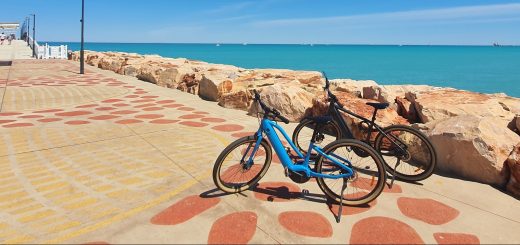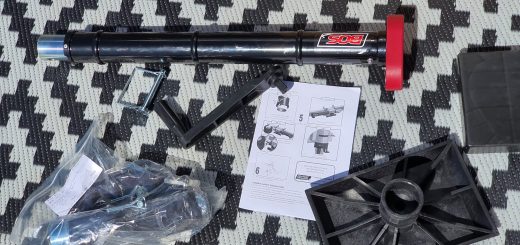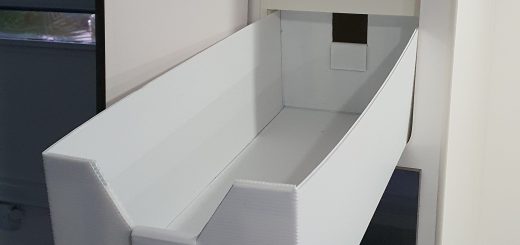Towing speeds around Australia
So how fast are you allowed to tow a caravan around Australia?

If you just want to jump down to the relevant speeds for the state you want to know about, use these quick links:
ACT, NSW, NT, QLD, Tas, Vic, WA.
Before that though, lets have a think about the maximum speed we should be towing at. Speed wobbles or sway in a caravan is directly related to the speed you are driving at and how the trailer is loaded. Every 10kmh in speed increases the possibility of trailer sway by 4 times, so going from 80kmh to 100kmh you are 16 times more likely to get a sway event happening. That’s not to say it will sway at 100kmh, the speed at which each complete setup will start to sway, what will trigger the sway and how severe the sway will be is mostly determined by how the caravan is loaded (as well as other issues such as suspension/shock absorber condition, cross winds, pot holes, tyre condition and pressure etc).
Speed of Sway initiating: Around 8% to 10% of the total loaded trailer weight (ATM) is the recommended tow ball down weight for best towing conditions and highest speeds that sway may start. Lower ball weights will bring in sway at a lower speed. Higher ball weights will potentially overload the rear axle of the tow vehicle and upset the vehicle handling (removing too much weight from the front wheels). Low tyre pressure will allow the van and car to move around on the tyres (sidewall flexing), too high a pressure will cause the tyres to bounce and have less grip. Worn shock absorbers or other suspension components will allow the van to move around on the suspension.
Severity of Sway: Majority of load towards the middle of the caravan (the axles) will produce the least intensity of sway and the easiest to recover from, heavier loads at the extremities (especially the rear if being used to offset heavey ball weight) will cause stronger and harder to correct sway (ie big heavy tool boxes on the front and rear) due to the pendulum effect they create.
So you can see we are dealing with two different things here – speed that sway may start and the intensity of the sway/wobbles once they do start.
How to stop the Sway: If you do have the unfortunate situation where sway/wobbles start, don’t panic, don’t slam on the brakes or the accelerator or try to steer left/right to match the sway, instead, calmly but quickly apply the trailer brake over ride control. You should know where this is and how to operate it, and by law it must be located in a position easily reached by the driver. Ideally a position where both the driver and passenger can easily reach it. If you have an electronic Anti Sway system installed, that is what these systems do – they detect the caravan swaying and automatically applies the caravan’s brakes. Basic systems like the ALKO apply all brakes the same as the manual over ride control, more advanced systems like the BMPro or Dexter will apply one side at a time to try and pull the van straight quicker.
If you are just starting out to tow a large van, I would highly recommend both a towing course and installing an Anti Sway Control system – both might save your life or the life of your loved ones.
The things NOT to do:
- Don’t slam the car brakes on
- Don’t try to steer out of it
- Don’t try to accelerate out of it.
The things TO do:
- Do keep steering wheel as still as possible (not spinning it left/right/left/right)
- Do apply the trailer over ride brakes to slow everything down as quickly as possible.
- Do apply tow vehicle brakes gently to slow quicker but you want to keep majority of the braking on the caravan.
I wont go further into caravan loading or preventing trailer sway here as that’s not what this post was about (I got sidetracked didn’t I), but I strongly suggest some good research and reviewing how your van is loaded.
General rule of thumb for towing pig trailer (yes, that’s the very apt technical name of most caravan designs) is to stay below 100kmh, ie around 90 to 95kmh. With strong cross winds or oncoming large truck slow down more, just to be safe.
OK, lesson over, now lets have a look, state by state, in alphabetical order.
Note, I have only listed the rural speed limits below, these are areas outside of residential. Residential standard speed limit for all states and territories is 50kmh unless otherwise specified.
Australian Capital Territory (ACT):
Maximum rural territory speed limit is 100kmh unless otherwise signed (ie, 110kmh Motorway).
ACT has no specific rules around speed when towing, so the maximum posted road sign speed limit is allowed.
New South Wales (NSW):
Maximum rural state speed limit is 100kmh unless otherwise signed (ie, 110kmh on the Motorway)
NSW allows the maximum sign posted speeds for GCM below 4.5t, or maximum 100kmh if the GCM is over 4.5t.
From the NSW RTA Website:
In the case of towing a single trailer, the driver driving a vehicle, with a gross vehicle mass (GVM) over 4.5 tonnes or a vehicle and trailer combination with a gross combination mass (GCM) over 4.5 tonnes, must not exceed 100 km/h, regardless of the signed posted speed limit. Always drive to the limits set by the manufacturer, as well as road, traffic and weather conditions.
As per the above, you can see that they have FINALLY updated the RTA website. It used to say if the GVM of the vehicle was over 4.5t then a max 100kmh applied. However legislation has always stated if the GCM is over 4.5t then 100kmh applied. The subtle difference for those not aware, the GVM is the weight of the tow vehicle alone (Gross Vehicle Mass) the GCM is the weight of the tow vehicle and caravan together (Gross Combined Mass).
This means for the majority of people towing a larger sized caravan the maximum speed will be 100kmh. So jump onto a weighbridge and find out what your total weight is.
Northern Territory (NT):
Maximum rural territory speed limit is 110kmh unless otherwise signed (ie sections of the main North/South highway is signed at 130kmh).
NT has no specific rules around maximum speed when towing, so the maximum posted road sign speed limit is allowed.
Queensland (QLD):
Maximum rural state speed limit is 100kmh unless otherwise signed (ie, Motorway 110kmh).
QLD has no specific rules around maximum speed when towing a trailer, so the maximum posted road sign limit is allowed.
South Australia (SA):
Maximum rural state speed limit is 100kmh unless otherwise signed (ie, Motorway 110kmh).
SA has no specific rules around maximum speed when towing a trailer so the maximum road sign limit is allowed.
Tasmania (Tas):
Maximum rural state speed limit is 100kmh unless otherwise signed (ie, Motorway 110kmh), however, Tasmania has a rule of maximum 80kmh for ALL vehicles on dirt roads.
Tasmania has no specific rules around maximum speed when towing, so the maximum posted road sign speed limit is allowed.
Victoria (Vic):
Maximum rural state speed limit is 100kmh unless otherwise signed (ie, Motorway 110kmh).
Vic has no specific rules around maximum speed when towing a trailer so the maximum road sign limit is allowed.
Western Australia (WA):
Maximum rural state speed limit is 110kmh unless otherwise signed.
In WA the speed limit for ALL vehicles towing is 100kmh (as well as all trucks over 12t GVM and all buses over 5t GVM). They also specify a distance of 60m to stay back from the vehicle in front if they are towing too.
From the WA Roads and Traffic website:
The maximum legal speed limit for any vehicle towing a trailer or caravan is 100km/h.
Vehicles towing a caravan or trailer must drive at least 60m behind heavy vehicles or other towing vehicles, unless overtaking.
OK, so hope that all makes sense and of course don’t hesitate to contact me if there are any errors or updates you are aware of.





Recent Comments